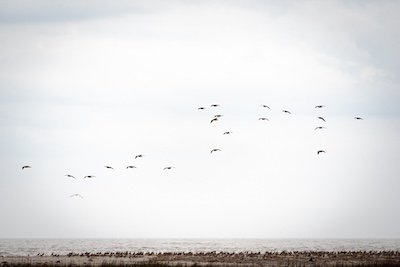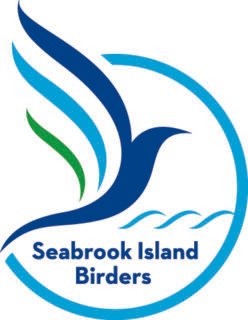
When the sun goes down on Seabrook Island, residents and guests alike make their way to beach Boardwalks 8 and 9 to watch the spectacular array of colors that make up our sunsets. It’s a beautiful sight, and a beachgoer’s dream.
There’s an uninhabited island just across the water, and as the sun drops lower in the sky, hundreds, even thousands, of birds can be seen flying in for the night, silhouetted against the orange sky. Gulls, terns, skimmers, and pelicans, just to name a few.
That island is called Deveaux Bank, owned and managed by the South Carolina Department of Natural Resources (SCDNR). It is one of only a handful of islands along the South Carolina coast to be designated as a seabird sanctuary. These uninhabited, offshore islands are free of mammalian predators and can therefore support colonies of nesting seabirds. It is also a highly coveted night roost for shorebirds and wading birds that come to seek shelter at sunset, especially during Spring and Fall migration.

In 2014, Felicia Sanders, SCDNR Coastal Bird Program Coordinator, made a remarkable discovery. She realized that Deveaux Bank was providing sanctuary for one such shorebird in particular, the Whimbrel. A lot of Whimbrels – at least 19,485! What she observed in 2014 turned out to be the most significant known roost of migrating Whimbrels in the Americas! Since that discovery, nocturnal surveys during spring migration have revealed that 25% of the entire North American population of Hudsonian Whimbrels can roost on Deveaux at one time.
And it’s not just Whimbrels. A total of 17,247 Red Knots have been estimated to use Deveaux Bank as a stopover to rest and feed throughout the spring. In addition, a total of “27 species have been recorded using Deveaux for breeding, roosting, feeding, wintering, or as a stopover site during migration”.
Based on these numbers, and the knowledge of its importance to shorebirds, on July 9, 2024, the Hemispheric Council of the Western Hemisphere Shorebird Reserve Network (WHSRN) approved Deveaux Bank’s designation as the 50th WHSRN site of the United States, and the 124th in the hemisphere.
So what exactly is WHSRN and what does it all mean? First of all, WHSRN holds no management or regulatory authority. That still falls under the care of the South Carolina Department of Natural Resources.
To quote the organization’s website, “WHSRN is a science-based, partnership-driven, conservation initiative for protecting the ecological integrity of critical habitats for shorebirds throughout the Americas.”
What is the benefit of being named an important site? It creates awareness on a global level, basically puting that site “on the map.” It helps guide planning and decision making, increases public recognition, enhances collaboration amongst other WHSRN partners, and gives the site managers access to the latest science and resources on shorebird conservation from the partner network.
There are three categories of site qualification, determined by peak species count:
Regional sites see at least 20,000 shorebirds annually, and/or 1% of the biogeographic population of a species.
International sites see at least 100,000 shorebirds annually, and/or 10% of the population of a species.
And Hemispheric sites have 500,000 shorebirds annually, and/or 30% of the population of a species.
Deveaux Bank earned an International Site of Importance designation, with 25% of the population of migrating Hudsonian Whimbrels.
But it doesn’t end there. With so much yet to learn about shorebirds, this designation is an exciting opportunity for the residents of Seabrook Island. It gives us a front row seat to the future of Deveaux Bank, our now world-famous neighbor. And also a responsibility to support and show respect for all shorebirds, whether they are visiting our beaches for a few weeks, or a full season.
Follow along over the months to come as we stay connected to SCDNR’s announcements about the birds and the island that is so much more than just a sandbar.
Watch the amazing video of the Deveaux Bank Whimbrel Discovery here.
Watch a follow-up video showing the results of GSP tracking data from individual Whimbrels on Deveaux Bank. Click here to watch.
To learn more about the Western Hemisphere Shorebird Reserve Network, click here.
Submitted by Gina Sanders in collaboration with SCDNR
